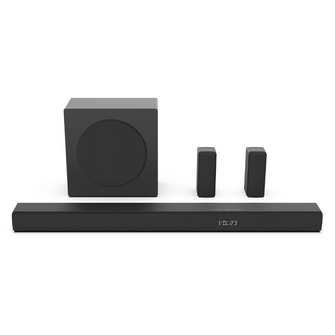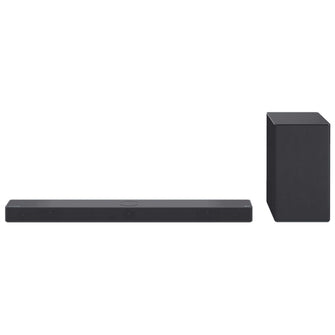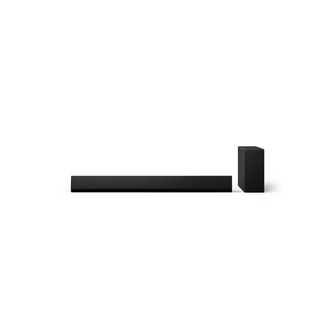A sound bar, sometimes called a television speaker bar, is the easiest way to upgrade your TV’s sound. Many shoppers search for better soundbar sound because modern flat TVs simply can’t deliver powerful audio on their own.
So you’ve taken the plunge and bought a new TV. Maybe it’s huge, maybe it’s got some super slick new technology, it’s probably got superior picture quality to your previous old TV and doesn’t need to be kicked in a specific spot to turn it on, much like your old TV did. Chances are the salesperson recommended a soundbar to go with your new TV and maybe you scoffed and said no thank you salesperson, you just want me to buy more stuff.
Well yes, they do, that’s their job. However there’s a few reasons why a soundbar is a great idea for your TV. I'll run through them today and recommend some good ones you can get at good old Bi-Rite.
What is a soundbar?
A soundbar, sometimes called a TV speaker bar, is a slim speaker system designed to improve your TV’s sound quality. It sits just below or in front of the screen and delivers clearer, more powerful audio than the built-in speakers in most TVs.
A basic soundbar is a single unit with multiple speakers inside, while more advanced models include extra features like subwoofers for deeper bass or surround sound technology for a more immersive experience. For most home setups, a soundbar is an easy and effective way to create a cinematic audio experience without the need for a full surround sound system. That’s why we recommend them as an essential part of any home theatre.
How do soundbars improve TV sound?
Much of a speaker’s sound quality comes down to its shape. The design of a speaker affects how sound waves travel, bouncing off walls and filling a room. In modern TVs, built-in speakers are often tucked away at the back of the display or squeezed into ultra-slim panels, which means they struggle to produce clear, powerful audio. That’s why dialogue can sometimes sound muffled or weak, especially in action scenes or reality TV drama.
A soundbar solves this problem by using multiple speakers housed in a single, elongated unit. This design allows sound to be projected more effectively towards the listener rather than being trapped inside the TV. Many soundbars also use digital signal processing (DSP) to enhance audio clarity, separate dialogue from background noise and create a wider, more immersive soundstage. Some even feature upward-firing speakers or virtual surround sound technology to mimic the effect of a multi-speaker home theatre setup without the need for extra cables or complicated installation.
Is a soundbar worth it?
A soundbar is absolutely worth it if you want to improve your TV’s sound without setting up a full surround sound system. It enhances dialogue clarity, boosts bass and creates a more immersive experience for movies, sports and gaming.
Like with any appliance, you need to consider the space where you’ll be using it. A soundbar works best in an average-sized lounge room or media room. In a large, open-plan space, the sound may not feel as full unless you pair it with a subwoofer or additional speakers.
Placement is also important. Make sure you have enough room in front of or below your TV. If your TV is wall mounted, you’ll need a sturdy shelf or cabinet for the soundbar, or you can mount it directly to the wall underneath your TV. Most soundbars are wall-mountable, so ask in-store about a compatible wall mount bracket.
If you want clearer sound, better bass and a more immersive TV experience without a complicated setup, a soundbar is a great investment.
Do I need a matching brand TV?
The short answer is no, but it’s always a good idea to check in-store to make sure the soundbar you want is compatible with your TV. Most soundbars are designed to work with any brand of TV, as long as they have the right connections, like HDMI ARC, eARC or optical audio.
That said, there are benefits to choosing a soundbar from the same brand as your TV. Many manufacturers design their TVs and soundbars to work seamlessly together, making setup easier and unlocking extra features. For example, LG’s Sound Mode Share and Samsung’s Q-Symphony synchronise sound from both the TV and soundbar, creating a more immersive surround sound experience.
If you’re unsure about compatibility or want to get the most out of your setup, ask in-store for advice on the best soundbar for your TV.
What to look for in a soundbar – techy bits!
Channels
Channels refer to the number of speakers inside the soundbar, which determine how sound moves around the room. More channels create a more immersive experience by directing sound to the left, right, centre and even above.
- 2.0 or 2.1 channels – Basic stereo sound, with the ".1" meaning an added subwoofer for deeper bass.
- 3.1 channels – Adds a centre speaker for clearer dialogue, ideal for movies and TV.
- 5.1 channels and above – Includes surround speakers or upward-firing drivers to create a true surround sound effect.
Power (measured in watts)
More power means louder and usually clearer sound. A higher wattage soundbar can produce richer audio, making a big difference in larger rooms.
Decoder and Audio Formats
The decoder processes audio formats to create the best possible sound. Most soundbars support Dolby Digital and DTS, the main formats used by streaming services and video games.
- Dolby Digital / DTS – Standard formats that compress the signal.
- Dolby TrueHD / DTS-HD Master Audio – Higher-resolution versions with uncompressed sound.
- Dolby Atmos / DTS:X – Premium formats that use height channels and surround speakers for 3D-like sound.
For the best audio quality, make sure your soundbar is connected to your TV using an eARC port. HDMI eARC (Enhanced Audio Return Channel) supports uncompressed high-resolution sound formats like Dolby Atmos, delivering the most immersive experience.
Which is the best soundbar?
The best soundbar for you is one that meets your unique needs and suits the content you’re watching. Each brand has different strengths and technologies, here’s an overview to help start your journey.
LG Soundbars
LG’s soundbar range is designed to complement their TVs with seamless integration and smart, room-filling sound. Most models support surround sound formats like Dolby Atmos and DTS:X, offering an immersive audio experience for movies, sport and music. Wireless subwoofers are standard, and many options include upward-firing speakers to enhance the sense of height and space in your soundstage.
LG soundbars tend to work best when paired with an LG TV, unlocking features like shared audio processing and one-remote control. They're a great fit for people who want plug-and-play simplicity with premium sound, especially in lounge rooms set up around an LG screen.
Hisense Soundbars

Hisense soundbars are good value, delivering feature-packed systems at a price that’s friendly to budget-conscious shoppers. Their soundbars often include multiple audio channels, wireless subs and even rear speakers in some models, making surround sound accessible without spending a fortune.
They also support major formats like Dolby Atmos, which is rare at this price point. Hisense soundbars are ideal for families, renters or first-time buyers who want serious audio improvements without going overboard, especially if you already own or are considering a Hisense TV.
TCL Soundbars
TCL’s soundbar range is all about delivering modern features at competitive prices, with a particular focus on simple setup and solid sound performance. Their lineup includes both compact models for smaller spaces and more advanced systems with subwoofers and multiple channels for a fuller audio experience.
Many models include support for Dolby Atmos and DTS:X, and some even offer custom tuning to optimise audio depending on what you’re watching. TCL soundbars suit people who want a no-fuss upgrade from their TV speakers and appreciate smart connectivity, especially if they already use TCL TVs or streaming devices.
Samsung Soundbars
Samsung’s soundbars are built for people who want a top-tier audio experience with plenty of smart features to match. They offer a wide range from compact models to full surround systems with wireless subs and rear speakers, all designed to work hand-in-hand with Samsung TVs. Most models support advanced sound formats and include AI-powered tuning that adapts audio to your room and content type.
Samsung’s ecosystem also offers benefits like shared speakers across the TV and soundbar, voice assistant integration and streamlined controls. These are best for tech-savvy households who want sleek design, powerful sound and smart home compatibility.
How to Connect a Soundbar to Your TV
Connecting a soundbar to your TV is usually quick and straightforward. The most common method is using HDMI ARC, but optical and wireless options are also available depending on your setup.
Here’s how to connect a soundbar using HDMI ARC:
- Locate the HDMI ARC port on your TV (usually labelled ‘HDMI ARC’ or ‘eARC’)
- Plug one end of a high-speed HDMI cable into the ARC port on the TV
- Plug the other end into the HDMI ARC port on your soundbar
- Turn on both devices and select the correct HDMI input
- Go into your TV’s audio settings and set the sound output to ‘HDMI ARC’ or similar
- Adjust volume or sound settings using your TV remote or the soundbar remote
Other options include:
- Optical cable: A simple plug-and-play option if your TV doesn’t support ARC
- Bluetooth or Wi-Fi: For wireless audio from compatible TVs and devices
Every brand is slightly different, so always refer to the manufacturer’s setup instructions for the best results.
Now you know…
Now you know a bit more about soundbars than you did before, and you’ve got some ideas on which ones you might like to try, go forth! Create the home cinema experience of your dreams. At least it’s not some guy playing the piano hectically like at an old-timey silent movie theatre. If you need a good starting point, come down to your local Bi-Rite for tailored advice, or shop online if you already have an idea of what you need. We’d love to see you.
Frequently Asked Questions
Is a TV speaker bar the same as a soundbar?
Yes. A TV speaker bar is just another way of describing a soundbar, which is a single slim speaker system that sits under your television to deliver clearer, more powerful sound.



















